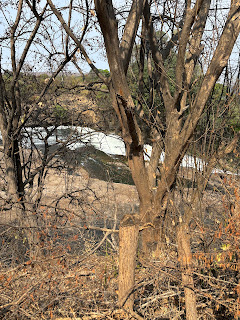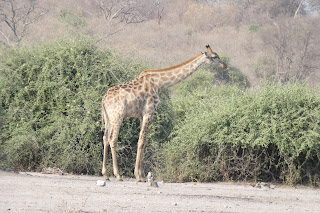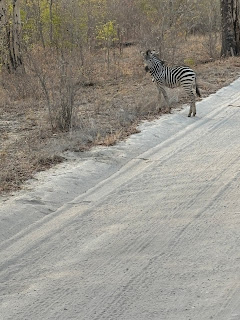Just wanted to send out some awesome pictures:
These Boots are made for Hiking
Moving on! More adventures and more traveling!
Search This Blog
Thursday, October 3, 2024
Victoria Falls
Victoria falls is the largest waterfall in the world. The volume of water changes with the seasons, but, when full, the spray rises to the sky a phenomenon that has given the falls the local name Mosi o Tonya the Smoke that Thunders. The falls measure 5,580 feet wide and 330 feet high. It was absolutely beautiful.
Wednesday, October 2, 2024
Hwange National Park and Lodge
OMG the Hwange Safarai Lodge makes this trip worth it. It is so beautiful, comfortable, food absolutely delicious. You have a full size window that looks out and see all the wild animals come to close several watering pools. After “wild camping”, no electricity, and fans that does not cool a safari tent in a 111 degrees, this is so deserved! I don’t want to complain but it was at time challenging. But it’s only for two days and then we are going back to Victoria Falls for our final leg.
Hwange National Park is the largest park in Zimbabwe. It covers 5,640 square miles. It’s home of 100 mammal species, 400 bird species which are all protected in this ecosystem. It was an amazing day. We saw 2 pride pack of lions, many, many herds of elephants (lots of baby elephants), different types of deer, and of course giraffes. We started out by 6:30 am and got back at 4 pm, which makes for a very long bumpy day! Here are pictures:
Tuesday, October 1, 2024
Matobo National Park
Matobo National Park is known for wildlife and kopjes (giant boulders that are stacked precariously). This park is one of the best places to see both white and black rhinos. I found that the difference between the two is that the white rhinos eat only grass while black rhinos enjoy twigs and bark as well as grass. Both are herbivores. This park is also known for its leopards but they are elusive and we didn’t see any. Our guide said in 15 years of doing this, he manage to see them only 6 times! This park is also home to a third of all eagle species.
Also, the hills here were home to an indigenous San people thousands of years ago. I was able to take a couple of pictures of their petroglyphs.
We are staying at Hermits Peak Lodge just outside the park. The lodge is own by a British couple and as we drove in they came out to welcome us. As it was Murphy Law played again. There was no electricity, they were waiting for repairs (but forgot to mentioned they been waiting several days for the repairs!). So we had a generator from 6 pm to 9 pm for dinner and shower and again from 6 am to 10 am for breakfast. Oh, only a fan but once the generator was turned off so was the fan! But the awesome part we did encounter a mom, dad and baby rhino. We had go in a single file and we got extremely close. I was a little nervous but it worked out. But coming back the dad woke up to we had to crouch and not move. They are very nearsighted but their hearing is excellent so he heard our movements. He got up and listened for a minute and he then turned around and laid back down! We hurry out of there. Here’s pictures of the day:
Monday, September 30, 2024
To Nata Makgadikgadi Salt Flats
After the “wild camping” in the delta I didn’t want any more non a/c accommodations! Well at Nata we had upgraded camp tent but with a fan in which the fan just kind of stirred the hot air around the room. It was 111 degrees and needless to say it was hot. We did drive out to the salt flats to see the wilderbeast. I got real close and some great pictures. The internet and electricity is intermittent here. So between I try to get out some information and pictures.
Saturday, September 28, 2024
Africa In Between Stops Information Termite Mounds
Having been around for over 50 millions years, the termite is one of most adaptable species on earth. These guys are not your typical American tiny, tiny termite, we are talking mounds from as small as a foot to well over 15 feet high! These termites have a caste system. There is a queen and king and their only duty is to produce. Then there is the workers soldiers and fertile aletes. They feed on a variety of plants and decaying wood. They covert this food into a mound that feels and looks like cement. The soldiers are also in charged of defending the mound. The predators are ant eaters, aardvarks, honey badgers, woodpeckers and larger ants. Once the predator invades the mound, the soldiers get to work cementing it back up. Pretty interesting how they do it. Below is a picture of one though there are thousands of the mounds in all shapes and sizes. Also other pictures of animals as we were driving:
























































